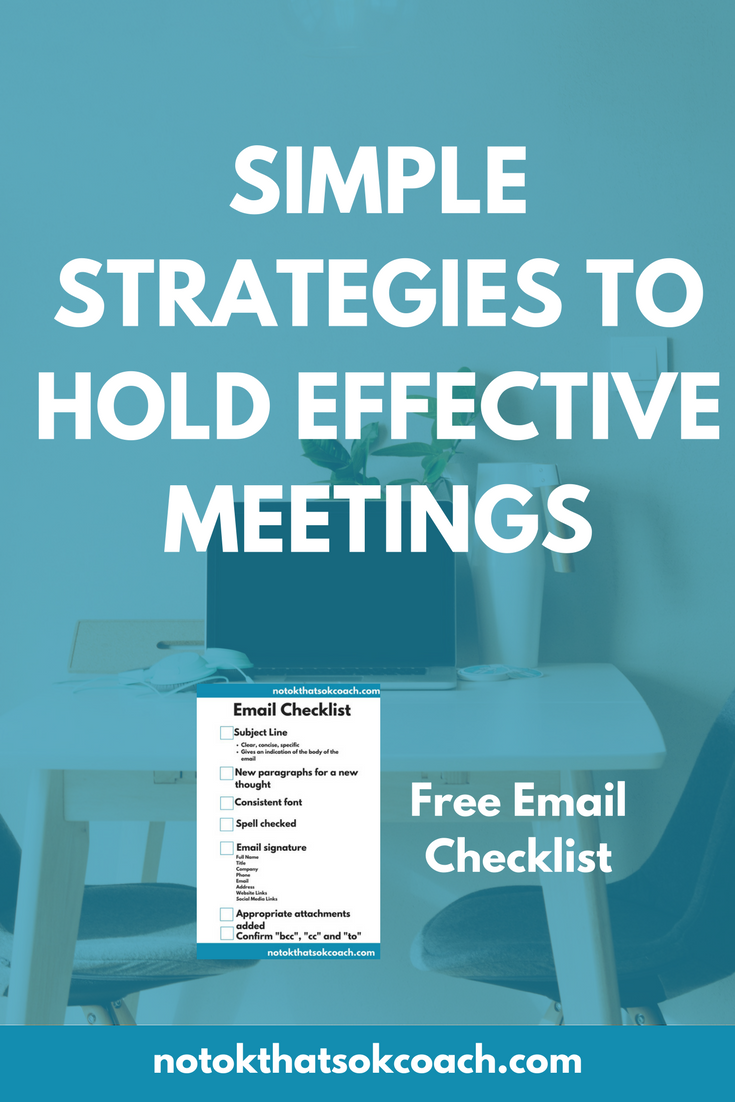Over the past decade I’ve been to so many ridiculous meetings! You know those meetings when you sit there and wonder why you’re even having them in the first place. The ones where your mind wonders on the million other things you have to do but can’t because you’re in this meeting. Yep, that one! Well, my friends have no fear I’ve come up with 7 strategies to hold effective meetings that don’t waste others’ time on ones that don’t need to happen.
Email.
Before scheduling a meeting, ask yourself this one question:
“Can this be done through a quick email?”
If so, do it! One rule of thumb is to look at your content to see if you’re looking for:
- Feedback
- Disseminating information
- Both
If your agenda would be filled with updates and things to keep in mind with no discussion-think email. If you’re looking for a discussion on a specific topic and need feedback, schedule your meeting.
For help writing an informative and detailed professional email, check out this post.
Distribute an agenda.
Before your meeting, send out a detailed agenda. This should not only include the topics for discussion but what the type of conversation you’re looking for so people can be prepared with their questions.
This agenda should be sent out in a timely fashion, preferably 1-2 business days prior. It’s the worst when someone sends out an agenda a few hours before and you’ve been in other meetings all day and unable to look at it.
Being the unprepared person in the room is never fun so spare everyone and send an agenda in advance.
Pre-brainstorm.
Some people can come up with ideas on the spot and others need some time. If you’re truly looking to include everyone’s ideas either ask people to come with them prior to the meeting with a detailed prompt or block off dedicated individual time during the meeting.
Either way, send your topic ahead of time. This gives each person the space to come up with their own ideas and then can bring it to the larger group feeling more prepared with their thoughts.
Change up the timing.
Is it just me or most meetings scheduled in 30 or 60 minute blocks of time?
If your meeting can be done in 15 or 20, block off that time and don’t add extra. With a smaller frame and specific agenda, people will more likely stay on task versus having those sidebar conversations.
End the meeting.
If your meeting is over in 20 minutes, don’t feel obligated to sit there for another 10. Give your team a free 10 minutes to finish another project they are working on. They will thank you later!
Tasks and next steps.
Never end a meeting without delegating the “what’s next.”
All attendees should know what they are responsible for and what might be coming down the pipeline. If there is nothing to wrap up you’ll wind up asking yourself why you had the meeting in the first place. If this isn’t a task you feel comfortable with, partner with someone who can pull it all together.
Follow up email.
You don’t need to take notes on every detail during the meeting, but you do need to send a follow up about what was discussed. This helps people see everything all together and the time to process and ask any questions. It also provides people who couldn’t attend with what was discussed.
Not only do now have the tools to hold effective meetings, you can feel empowered to talk with others who might be planning one of their own. Feel free to just slip this post to your coworkers as a subtle hint to make your next meeting really matter!
- Cultivating Relationships - July 20, 2021
- Empowering Our People - July 13, 2021
- Finding Purpose - July 6, 2021





These are so good!! I’m going to send this to my boss 😉
Aw, thanks and that’s such a good idea!
Where has this list been all my life?! So brilliant! I hate those meetings where it seems like everyone is talking and talking and talking and not SAYING anything! Such awesome strategies to prevent that here!
It’s so crazy how many meetings we go to, that are a complete and total waste of time! I’m so glad you liked it, Misty!
Such great content! Awesome tips for holding meetings!
Thanks, Brittany!
Super content! Lots of great tips for holding meetings. Thanks so much for all the advice.
Thanks, Heather!
These are such great tips! I always feel like meetings are more productive when i really think about them before hand
These are all fantastic ideas! Thanks for sharing!
This is a great checklist! I love how helpful this could be to someone who is consistently collaborating and working with others! Great tips!
These are such great tips for meetings, and when to hold them!
This post is full of excellent information. Thank you so much! May we never waste time in an ineffective meeting again.
There are so many great suggestions in here about how to have a meeting. I too have found myself stuck in meetings that seem to start off right but then quickly get off topic. I usually end up leaving those meetings feeling like nothing was accomplished. I’ll definitely try to implement some of these strategies in the future.
This was such a good read! You offered lots of great tips and advice!
Such a great post! I’ll definitely be referring to these tips during my mentoring/coaching sessions!
These are great tips! I always love your checklists and worksheets!
Thanks so much Lecy! Happy Monday!
I love that checklist! It will become a must for emailing! Planning meetings is a hard thing for me to do…So I avoid it until I have too and then I am throwing it together.
Thanks so much Jenn and I am so glad the checklist will help! Planning meetings is never easy but glad this helped!